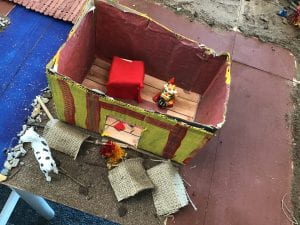This term we have been learning about the gold rush and our intergraded title is the hard road ahead. We have been learning about the gold rush by going on camp, visiting a museum doing research and eventually building a diorama of Sovereign Hill.

One of the things we learnt about was life in the 1850s.
At camp we had to dress up as children for the 1850s and became a part of the museum. We learnt that girls came first and life was hard because everyone owes in one place and there weren’t enough houses to go round so many had tents or huts to live in. The mud did not help much ether.

We also learnt about business in the gold rush era. Some business did well in the 1850s while others struggled. We were given a business to build for our diorama. First we had to question the shop owner about its business in the gold rush. We had to ask about what the shop sold who it attracted and when it shut down. We got the saddlery and my partner was Billy and we could not have done it if we didn’t work together.


The thing we probably focused on the most was the Eureka stockade because it played a great part in the governing of Australia and is what the Australian gold rush was most famous for (except gold). We learnt about Peter Lalor and the Eureka rebellion against the red coats.
At the Museum we went to we saw the Eureka flag(it was much bigger than we thought it would be). We also learnt that the Eureka stockade fell on December the 3 at three am in the morning.


Some important figures for the time were Peter Lalor and Governor Hotham. Lalor was an Irish man and had survived the potato famine and had worked building railways before the gold rush. Governor Hotham was the governor at the time of the stockade and he had spies in the stockade telling him when the best time to attack was.
Important dates we learnt about were 1823 when gold was first found in Australia but the finders tried to keep its secret but word got out. The 12th of Jan 1851 Edward Hargreaves find gold near Bathurst. The 7th of Oct 1854 James Scobie a digger was murdered by James Bentley. Then on 17th of October the diggers protested for Scobie and burned down James Bentley’s hotel. And on the 3rd of December, the Eureka stockade battle, where 27 people were killed and the battle lasted 20 minutes.
When we made our diorama we got in to pairs of our teachers choosing. I was with Billy and we made the saddlery and Chinese camp. The saddlery was created in 1861 by Joseph Gray who was a prize-winning exhibitor of harnesses at Ballarat’s early Agricultural Society shows.
The saddlery sells horse saddles, harnesses, bits, spurs, riding crops, stock whips and horse brasses.
It also sold wallets leather dressing, hats and saddle soap. This shop was aimed at horse owners and shut down shortly after the gold rush because horses became less popular and the flow of people from other country’s with horses stoped.The horse business today Is not as popular for we have cars.

 I really enjoyed the gold rush unit and we have had to use had to use communication and collaboration to achieve our goal. It was a great topic and I hope to do a similar thing soon.
I really enjoyed the gold rush unit and we have had to use had to use communication and collaboration to achieve our goal. It was a great topic and I hope to do a similar thing soon.

What would you have made for our diorama?










